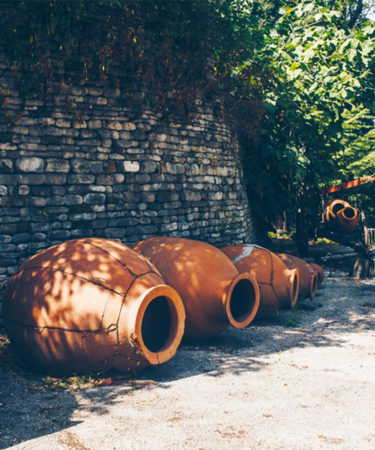Located on the border of Eastern Europe and Asia, Georgia has an astonishing 8,000-year-old winemaking history. Central to the nation’s oenological heritage are its skin-contact qvevri wines, widely consumed by those in Georgia and neighboring countries for millennia. Thanks to a growing worldwide trend of “natural” winemaking, the category’s undisputed OG is now garnering international attention.
While natural winemaking shares many of the same principles as qvevri winemaking — skin-contact fermentation and the use of naturally occurring yeasts — the overall process is markedly different. The resulting style of each wine, too, is distinct.
To help you better understand the less-common, but ever-more-prominent, qvevri wines, here’s everything you could hope to know (but were too shy to ask).
What actually are qvevri?
Qvevri, or kvevri as the name is also written, are large, egg-shaped terracotta clay pots used for the fermentation and maturation of wine. To this day, qvevri are constructed using some of the original techniques developed with the birth of pottery many thousands of years ago.
Are they the same as amphorae?
Amphorae are another type of ancient clay vessel associated with wine, but they differ from qvevri in some important ways.
The first is shape: Amphorae have handles — an important distinction that also highlights the different functions of each. In ancient Greece and Rome, amphorae were used exclusively for the transportation and storage of comestibles like wine and olive oil.
Qvevri, on the other hand, have always been an integral part of the winemaking process. They are unsuitable for transportation, given their size and the fact that they’re buried underground.
Why are they buried underground?
As demand for wine increased in ancient Georgia, winemakers used budding technology to build larger qvevri, enabling them to produce a higher volume of wine per vessel. But as size increased, the clay structures became unstable under their own immense weight, not to mention the build-up of pressure during fermentation. To help stabilize the process, winemakers started burying qvevri underground.
In doing so, winemakers stumbled across an ancient form of refrigeration (temperatures are cooler underground). This provides a longer maceration period for grapes on fermenting must, which would otherwise cause wine to spoil above ground. The extended maceration period develops an increase in aroma and flavor profiles in qvevri wines.
How many times can qvevri be used?
One of the final stages of qvevri construction involves coating the inside of the pot with beeswax (though the pots themselves remain porous, allowing some air to pass through during fermentation). The beeswax helps to waterproof and sterilize qvevri, making winemaking a more hygienic process and the vessels easier to clean after each use.
Once they are installed underground, if cleaned and maintained correctly, qvevri can be used for many hundreds of years.
Are qvevri wines made using red or white grapes?
Both red and white varieties are used, albeit separately. While Georgia has many hundreds of native varieties, the most common are the white Rkatsiteli and the red Saperavi. In general, red-wine production dominates the western regions of Georgia, with white varieties more prominent in the east. Overall, more grapes are grown in the east of the country, making white qvevri wines more common than reds.
How exactly do you make wine using qvevri?
Grapes are partially pressed before they enter qvevri for fermentation. Depending on the climate of the region, skins and stems may also be included, though in colder regions this can develop undesirable “green” characteristics.
Fermentation begins after a few days and continues for anywhere between two and four weeks until the solid mass of skins and stems, or cap, sinks from the surface of fermenting juice.
As in modern winemaking, the cap is like a kind of tea bag, imparting flavors, aromas, and tannins to grape must. During fermentation, this cap is “punched down” twice daily to increase its impact on wine.
Once the cap finally falls, the skins and stems are removed for red wines, while whites are left in contact. At this point, qvevri are covered with stone lids, and malolactic fermentation, the process in which tart-tasting malic acid is converted to softer-tasting lactic acid, begins soon after. Wines are left to mature for around six months, during which time lees and solids fall into a section at the base of the vessel where their contact (and impact) is minimal.
At the end of the process, wine is transferred to a freshly cleaned qvevri or another storage vessel until bottling. Occasionally, it is bottled right away.
What do qvevri wines look, smell, and taste like?
Owing to skin-contact fermentation, qvevri wines made using white grapes are actually much more of a dazzling orange in color. Red wines are indistinguishable from modern styles, though Saperavi as a variety produces intensely colored, inky wines.
Qvevri wines are intensely aromatic, displaying an intriguing mix of fruit and savory characteristics. Among these are oxidative notes, which are developed thanks to the vessel’s porosity.
Beyond color, skin-contact fermentation also boosts tannins. This is not uncommon for reds, but it is remarkable for whites, which offer a challenging texture for those unfamiliar with the style. For best enjoyment, whites should be served at a cool cellar temperature (55 to 60 degrees), rather than chilled, to fully appreciate their complexity. Reds, meanwhile, should be enjoyed just like a full-bodied modern style, between 65 and 70 degrees.
